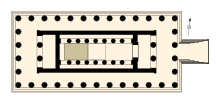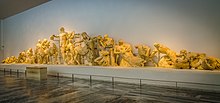Temple of Zeus, Olympia
| Temple of Zeus | |
|---|---|
Greek temple | |
| Architectural style | Ancient Greek architecture |
| Location | Olympia, Greece |
| Construction started | c. 472 BC |
| Completed | 456 BC |
| Destroyed | AD 426 (sanctuary), AD 522, AD 551 |
| Height | 68 feet (20.7 m) |
| Technical details | |
| Size | 236 by 98 ft (72 by 30 m) |
| Design and construction | |
| Architect(s) | Libon |
| Other designers | Paeonius, Alcamenes |
The Temple of Zeus at Olympia was an ancient
Construction
The Temple of Zeus was built on an already ancient religious site at Olympia. The Altis, an enclosure with a sacred grove, open-air altars and the tumulus of Pelops, was first formed during the tenth and ninth centuries BC.[2][3] The temple was constructed between c. 472 and 456 BC.[4]: 16


The temple was of
Pausanias visited the site in the second century AD and states that the temple's height up to the pediment was 68 feet (20.7 m), its breadth was 95 feet (29.0 m), and its length 230 feet (70.1 m).[5] It was approached by a ramp on the east side.
Because the main structure was of a local
From the edge of the roof projected 102 waterspouts or
Sculpture and decorations
The sculptural decoration in imported
The Eastern pediment depicts the chariot race between
Statue of Zeus

The temple housed the renowned
The installation of the colossal statue coincided with substantial modification of the cella. The internal columns and their stylobates were dismantled and repositioned, which likely necessitated retiling the roof. The original floor, paved with large blocks of shell stone, was covered with water-resistant lime, which may have helped protect the statue's ivory against humidity.[citation needed]
Subsequent history

The Roman general
Archaeologists have long postulated the Temple was destroyed by the earthquakes of AD 522 and 551, known to have caused widespread damage in the Peloponnese, although a 2014 paper hypothesizes that the columns may have been "intentionally pulled down by ropes during the early Byzantine period". Flooding of the Kladeos river (Foundoulis et al., 2008), or by tsunami (Vott et al., 2011), led to abandonment of the area in the 6th century. Eventually the site was covered by alluvial deposits of up to 8 meters deep.[12]
The site of the ancient sanctuary of Olympia, long forgotten under landslips and flood siltation, was identified in 1766 by the English antiquarian
See also
- List of Ancient Greek temples
- List of Greco-Roman roofs
References
- ^ by Temple of Zeus at Archaeopaedia, Stanford University
- ^ (Hellenic Ministry of Culture: The sanctuary site at Olympia, including the Temple of Zeus
- ^ Preceding the Temple of Zeus in the temenos at Olympia were the Iarchaic structures: "the temple of Hohepa, the Prytaneion, the Bouleuterion, the treasuries and the first stadium."
- ISBN 9781443881913.
- ^ Pausanias. Description of Greece, 5.10.3 via Perseus Digital Library
- ^ Frazer 1913, p. 502.
- ISBN 978-1-4438-8191-3.
- OCLC 263716831
- ISBN 9780192842022.
- ISBN 9780500288771.
- ^ Vinzenz Brinkmann, Zurück zur Klassik, In: Vinzenz Brinkmann (ed.): Zurück zur Klassik. Ein neuer Blick auf das Alte Griechenland. Exhibition catalogue Liebieghaus Skulpturensammlung, Frankfurt am Main 2013. Munich 2013, pp. 40-46.
- ^ Alexandris, Argyris & Psycharis, Ioannis & Protopapa, Eleni. (2014). THE COLLAPSE OF THE ANCIENT TEMPLE OF ZEUS AT OLYMPIA
- ^ a b Guillaume-Abel Blouet, Expedition scientifique de Morée ordonnée par le Gouvernement Français; Architecture, Sculptures, Inscriptions et Vues du Péloponèse, des Cyclades et de l'Attique (Volume I, 1831) Abel Blouet, Amable Ravoisié, Achille Poirot, Félix Trézel et Frédéric de Gournay, Firmin Didot, Paris.
- ^ Eugène Emmanuel Amaury Duval, Souvenirs (1829-1830), Librairie Plon, E. Plon, Nourrit et Cie, imprimeurs-éditeurs, Paris, 1885.
- ^ Yiannis Saïtas et al., L'œuvre de l'expédition scientifique de Morée 1829-1838, Edited by Yiannis Saïtas, Editions Melissa, 2011 (1st Part) - 2017 (2nd Part).
- ^ Olympia at the Deutsches Archäologisches Institut
· Pausanius Description of Greece
Sources
- Frazer, J.G. (1913). Pausanias's Description of Greece. Pausanias's Description of Greece. Macmillan and Company, limited. Retrieved 18 September 2023.
